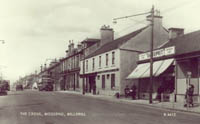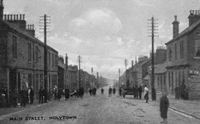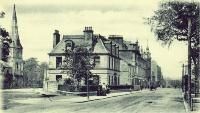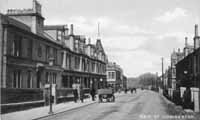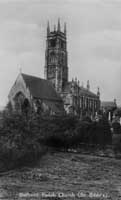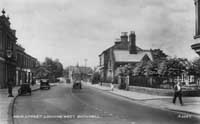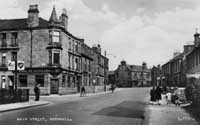Bothwell Parish
Information specific to this area can be found below and on the left
menu bar. We also recommend consulting the many general pages for
information of general relevance to miners' lives.
Bellshill
The name Bellshill is thought originate from the farm at Belziehill, occupied by a Mr Bell. With the growth of the coal and iron industry the population rapidly increased from 1013 in 1861 to 8786 in 1911 and 17,411 by 1931.
Coal was mined in the New Stevenston area as early as the first quarter of the 17th century. By the 1870's deep lying seams in the Bellshill Bothwell and Uddingston areas were being mined and the area rapidly expanded. By 1925 when Orbiston Colliery was shut the mining industry in the area was in decline. From the 1930s onwards numerous pits in the area were closed including Hattonrig and Bothwell Park in 1932, Holytown and Wood Hall in 1939, Viewpark, 1942 Tannochside, 1945 and Thankerton in 1953.
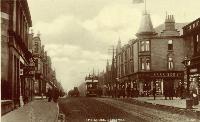 | 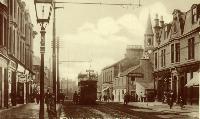 Above: Views of Bellshill Cross Above: Views of Bellshill Cross |
Bellshill, a mining town of Bothwell parish, N Lanarkshire, 9 miles by road ESE of Glasgow, 3 5/8 S of Coatbridge, and 4 N by E of Hamilton, with stations on the Uddingston and Holytown branch of the Caledonian, and on the Glasgow, Coatbridge, and Hamilton branch of the North British-both opened in 1878. It has a post office, with money order and savings' bank departments, gas-works, a branch of the Bank of Scotland, and Established (1876), Free (1874), U.P., and Evangelical Union churches, having in 1878 been erected into a quoad sacra parish, in the presbytery of Hamilton and synod of Glasgow and Ayr. Two schools, Bellshill and West End, had (1879) a respective accommodation for 288 and 262 children, an average attendance of 232 and 187, and grants of £176 8s., and £163 12s. 6d. Pop. (1841) 1013, (1861) 2945, (1871) 2233, (1881) 2572, many of them colliers or iron-workers. [Ordnance Gazetteer of Scotland, Francis H Groome, 1885]
Mossend
Mossend, a town in Bothwell parish, Lanarkshire, 7 furlongs E by N of Bellshill, 1 1/4 mile W of Holytown, and 4 1/4 miles S by E of Coatbridge. Of recent origin, it has a station on the Caledonian railway, a post and telegraph office, extensive iron and steel works, public and Roman Catholic schools, and a fine new Roman Catholic church, erected in 1883-84 from designs by Messrs Pugin. Pop. (1871) 1501, (1881) 3030, of whom 1701 were males. Houses (1881) 531 inhabited, 23 vacant. [Ordnance Gazetteer of Scotland, Francis H Groome, 1885]
Holytown
Holytown, a town in Bothwell parish, Lanarkshire, 1 mile E by N of Holytown Junction on the Caledonian railway, 5 1/2 miles SSE of Coatbridge, and 11 ESE of Glasgow. Surrounded by a well-worked part of the Lanarkshire mineral-field, and partaking largely in the industry and traffic connected with the working of the same, it experienced considerable increase of prosperity from the opening of the Cleland and Midcalder railway (1866), in result partly of through traffic on that line and partly of junction-communication with Motherwell. It includes the suburb of New Stevenston, 1/2 mile SSW ; and has a post office, with money order, savings' bank, and telegraph departments, a branch of the Clydesdale Bank, 3 insurance agencies, gasworks, a quoad sacra parish church, a Free church, and a public school. The quoad sacra parish is in the presbytery of Hamilton and synod of Glasgow and Ayr ; its minister's stipend is £120. Pop. of town (1836) 755, (1861) 1135, (1871) 2197, (1881) 2480, of whom 1048 were in New Stevenston ; of q. s. parish (1871) 10,099, (1881) 10,449[Ordnance Gazetteer of Scotland, Francis H Groome, 1885]
Uddingston
Uddingston, a thriving town of recent growth in Bothwell parish, Lanarkshire, near the right bank of the Clyde, 3 3/4 miles NNW of Hamilton, and 7½ ESE of Glasgow. Standing amid pleasant environs, and commanding a brilliant view down the valley of the Clyde, it chiefly consists of modern, well-built houses, occupied by Glasgow merchants, carries on an extensive manufacture of agricultural implements (the 'Wilkie's plough' dating from 1800), and has a post office, with money order, savings' bank, and telegraph departments, a branch of the Bank of Scotland, stations on the Caledonian and North British railways, gasworks, a public hall, a sessional school, etc. The Established church, built as a chapel of ease in 1873 at a cost of over £4000, was raised to quoad sacra parochial status in 1874. It is an Early English structure, with 850 sittings, and a tower and spire 100 feet high. The Free church, built in 1876 at a cost of £3300, contains 500 sittings; and there are also a U.P. church (450 sittings), a handsome Early Gothic Evangelical Union church (1880; cost over £1500; 400), and St John the Baptist's Roman Catholic chapel school (1883; 600). Two early British urns were dug up in 1885. Pop. of q. s. parish (1881) 4086; of town (1841) 703, (1861) 1256, (1871) 1997, (1881) 3542, of whom 1818 were females. Houses in town (1881) 673 inhabited, 53 vacant, 19 building. [Ordnance Gazetteer of Scotland, Francis H Groome, 1885]
Bothwell
Bothwell, a village and a parish of N. Lanarkshire. The village stands in the SW corner of the parish, near the right bank of the Clyde, here spanned by a suspension bridge leading to Blantyre Works, and by Bothwell Brig, leading to Hamilton; by road it is 2 1/4 miles NW of the latter town, 8 SE of Glasgow, and 36 1/2 WSW of Edinburgh, having stations on branches of the Caledonian and North British, opened in 1877 and 1878. A pleasant, healthy place, commanding charming vistas of Strathclyde, it mainly consists of plain red sandstone houses, studded with villas and cottages-ornées, the summer resorts of Glasgow citizens; is lighted by gas; and has a post office, with money order, savings' bank, insurance, and telegraph departments, a branch of the Clydesdale Bank, two hotels, and a public library. The parish church here is a fine Gothic edifice built in 1833 at a cost of £4179, and, containing 1150 sittings, uprears a massive square tower to the height of 120 feet; E of which tower is the ruined choir of the old collegiate church, an interesting specimen of Second Pointed architecture, measuring 53 1/2 by 21 2/3 feet, and retaining a N sacristy (13 1/3 by 9 5/6 feet), a piscina, 3 canopied sedilia, and monuments to the two Archibald Douglases, Earls of Forfar, the second of whom was mortally wounded at Sheriffmuir (1715). In this old church, founded in 1398 by Archibald 'the Grim,' Earl of Douglas, for a provost and 8 prebendaries, David, the hapless Duke of Rothesay, wedded the founder's daughter, Marjory, in 1400. One of its early provosts was Thomas Barry, who celebrated the victory of Otterburn in Latin verse; and in the former manse was born the poetess, Joanna Baillie (1762-1851). The Free church, rebuilt in 1861 at a cost of £3500, is another good Second Pointed structure, with 880 sittings and an octagonal spire, 125 feet high; the U.P. church is seated for 360. A public school, with accommodation for 182 children, had (1879) an average attendance of 135, and a grant of £118 15s. Pop. (1861) 1057, (1871) 1209, (1881) 1535.
The parish contains also the towns of UDDINGSTON (1 3/8 mile NNW of Bothwell village), BELLSHILL (2 1/4 NE), and HOLYTOWN (4 1/4 ENE), with portions of CALDERBANK (6 NE) and CLELAND (7 E), and the villages of NACKERTON (2 1/2 N by W), Carnbroe (4 NE), MOSSEND (2 3/4 NE), New Stevenston (4 5/8 E by N), Legbranock (5 3/4 ENE), Newhouse (6 3/4 ENE), CHAPELHALL (6 3/8 ENE) CARFIN (5 1/2 E), and NEWARTHILL (5 3/8 E by N). [Ordnance Gazetteer of Scotland, Francis H Groome, 1885]
Ordnance Gazetteer of Scotland, Francis H Groome 1885
Carfin, a collier village in Bothwell parish, NE Lanarkshire, 1 3/4 mile NE of Motherwell, under which it has a post office. At it are a reading-room, St Francis Xavier's Roman Catholic church (1881), and three schools - boys', girls', and Roman Catholic. With respective accommodation for 110, 127, and 193 children, these had (1880) an average attendance of 88, 79, and 263, and grants of £86, 11s., £69, 2s. 6d., and £179, 14s. Carfin House stands 1/2 mile to the S, on the right bank of South Calder Water. Pop. (1861) 1342, (1871) 1111, (1881) 1229.
Calderbank, a large industrial village of NE Lanarkshire, partly in Bothwell but chiefly in Old Monkland parish, on the North Calder Water, 2 miles SSE of Airdrie. It has a post office under Airdrie, a board school, and an Established chapel of ease; and at it are situated the iron-works of the Monkland Company, with 6 blast furnaces, 46 puddling furnaces, and 6 rolling mills. The school, with accommodation for 252 children, had (1879) an average attendance of 186, and a grant of £158, 9s. Pop. (1841) 1064, (1861) 2461, (1871) 2176, (1881) 1739.
Chapelhall, a large village in the NE of Bothwell parish, Lanarkshire, near the left bank of North Calder Water, 2 miles NNE of Holytown, and 2 1/2 SE of Airdrie, under which it has a post office. Chiefly dependent on the iron works and collieries of the Monkland Company, it is of recent origin, and consists of well-built houses, nearly one-half of them the property of operatives; at it are a Free church, St Aloysius Roman Catholic church (1859), and a public and a Roman Catholic school, which, with respective accommodation for 250 and 249 children, had (1880) an average attendance of 229 and 192, and grants of £199 5s. and £135 8s. Pop. (1841) 1431, (1861) 1990, (1871) 1707, (1881) 1675.
Newarthill, a mining village in Bothwell parish, Lanarkshire, 1 3/4 mile E by S of Holytown, and 3 miles ENE of Motherwell. Standing amid a rich mineral tract, it has a post office under Motherwell, a UP church (1810; 600 sittings), and a public school. Pop. (1841) 968, (1861) 1382, (1871) 1530, (1881) 1355. - Ord. Sur., sh. 31, 1867.
A topographical dictionary of Scotland, Samuel Lewis, 1846
Bellshill, a village, in the parish of Bothwell, Middle ward of the county of Lanark, 1 1/2 mile (E.) from Bothwell; containing 1013 inhabitants. It lies on the great road from Edinburgh to Glasgow, and the hill from which it is named attains an elevation of 372 feet above the sea: the population partake in the manufactures of the parish. There is a post-office, also a Relief meeting-house, and two schools.
Bothwell, a parish, in the Middle ward of the county of Lanark ; including the villages of Bellshill, Chapelhall, Holytown, Newarthill, and Uddingston; and containing 11,175 inhabitants, of whom 570 are in the village of Bothwell, 8 miles (S. E.) from Glasgow. The name is supposed, by some, to be derived from Both, an eminence, and wall, a castle, terms applied to the parish from the elevated situation of Bothwell Castle above the river Clyde; others derive it from two Celtic words, both, signifying a dwelling, and ael, or hyl, a river, as descriptive of the castle in its contiguity to the river. This extensive barony, in the reign of Alexander I., was held by Walter Olifard, justiciary of Lothian, who died in 1242; it afterwards came into the possession of the family of Moray, consisting, at that date, of a tower and fortalice, with their appurtenances, and of lands in various districts, constituting a lordship. In the time of Edward I. of England, it became a place of great importance, and it appears that that monarch resided in the castle from the 17th to the 20th September, 1301 ; in this reign, also, it was the residence of Aylmer de Valence, Earl of Pembroke, who fled hither from London Hill, where he had been defeated by Wallace, in 1307, and who, in 1309, was made governor of the castles of Selkirk and Bothwell. At the time of the battle of Bannockburn, Sir Walter Fitzgilbert, ancestor of the Hamilton family, was governor, and after the death of Bruce, when Edward III invaded Scotland, in 1336, the king was at the castle from the 18th November till the 13th December, in the course of which time fifteen writs were issued thence, in his name. It came, at length, to the Earl of Bothwell, from whom it descended to Archibald the Grim, Earl of Douglas; and, after passing through many other hands, it reverted to the ancient family of Douglas in 1715. The collegiate church of Bothwell was founded on the 10th October, 1398, in the reign of Robert II., by the first earl of Douglas, for a provost and eight prebendaries, and was richly endowed. Most of the superiorities, with part of the property, and all the tithes, now belong to the Duke of Hamilton. Bothwell-Bridge, in the southern part of the parish, is celebrated in history for the battle fought there, in 1679, between the Covenanters and the Duke of Monmouth; and at a little distance, is Bothwell-Haugh, formerly the property of James Hamilton, who shot the regent Murray, for confiscating a part of his estate, and the barbarous treatment of his wife, on account of his having espoused the cause of Mary, Queen of Scots.
The parish is, in extreme length, about 8 1/2 miles, and varies in breadth from 2 to 4 miles, containing 13,600 acres; it is bounded on the north and west by the North Calder, and on the south, by the South Calder and the river Clyde. It is comprehended by the elevated ground running along the north-eastern bank of the Clyde from Lanark to near Glasgow, which range, however, recedes from the river in traversing this district, and leaves an intermediate plain, till it again inclines to the stream in the neighbourhood of Bothwell-Bridge. Near this it forms a piece of table-land of about one mile in extent, running to the westward, at the head of which are situated the church and village, about 130 feet above the level of the sea, and commanding a beautiful view, to the east, of the vale of Clyde. From the eastern boundary of the parish, the land falls rapidly to a distance of nearly four miles, after which a flat succeeds, of about equal length, declining southward towards the Calder and Clyde, and the western extremity of this tract sinks gradually into the extensive plain on, which Glasgow is situated. The Clyde, the chief river, enters the parish at Bothwell-Haugh, and forms a majestic stream, the banks of which are famed for their diversified and picturesque scenery; it is 120 yards broad at Blantyre-Works, but at Bothwell-Bridge contracts itself to a span of 71 yards. The North and South Calder, after running separately for about 15 miles, form each a confluence with the Clyde ; they flow between banks of sandstone rock, beautifully abrupt in many parts, and affording well-wooded and romantic scenery. Of these rivers, the Clyde, once so celebrated for the abundance of its salmon, has now greatly fallen off in this respect, very few fish comparatively visiting it, owing to many causes, one of the most considerable of which is said to be the impediment presented to their progress by the dam thrown over the river between Blantyre Mill and Bothwell.
The prevailing soil is clay, resting upon a tilly subsoil, and is frequently, and in various proportions, mixed with loam and sand; in some places it consists of fine light mould, and in the vicinity of the rivers is a fertile alluvial deposit. The whole land is productive, with small exceptions of moss and moor ; two-fifths are in pasture, and grain of all kinds, and of good quality, is raised; potatoes, turnips, peas, &c., are also cultivated in considerable quantities, with some flax, though this last is not grown so largely as formerly. Very great attention is given to dairy-farming, there being no less than 1000 cows kept, most of which are native varieties of the Ayrshire breed ; the horses are in general likewise of a good stock. The rateable annual value of the parish is £35,207. The predominating rock is the red sandstone, which lies over the whole coal-bed in this district, at a distance of twenty or thirty fathoms above the coal; it is bright in. colour, and, though sometimes soft and friable, generally well adapted to buildings. There are several quarries of good freestone near the Clyde, of a red colour; and in the upper parts of the parish, white freestone is found. Coal abounds in every direction, and four large seams from which it is chiefly procured, extend throughout the parish, in which the Ell-coal, Pyotshaw, main, and splint coal succeed each other, the last being best suited for the smelting of iron, the average amount of coal obtained, in value, is estimated at £80,000 annually, and of ironstone and other minerals, £20,000.
The chief mansion is Bothwell Castle, a simple, yet commodious residence, built of the same red sandstone as the old castle, and consisting of an extensive front and two wings ; the apartments are ornamented with several excellent portraits. The grounds are elegantly laid out, and the neighbouring scenery, comprising the waters of the Clyde and its picturesque banks, is ennobled by the ancient and venerable ruin of the old castle. The mansion of Woodhall, on the bank of the North Calder, is a spacious building in the style of the age of Louis XIV.; valuable pictures adorn some of the apartments, and the entrance-hall contains several French cuirasses and helmets of brass, brought from the field of Waterloo. The mansions of Cairnbroe and St. Enoch's Hall, both on the North Calder; Cleland, Carfin, Jerviston, and Douglas Park, are all superior residences, standing in the midst of interesting scenery ; and Bothwell Park, a handsome commanding mansion, has a fine view of the fertile haughs of Hamilton, and of the vale of Clyde. The principal manufactures of the parish are those of pig-iron and steel, the former of which is produced at the Monkland Company's works at Chapelhall, to a great extent ; about 100 tons of steel are manufactured annually, 30 tons of which are made into files, and upwards of 700 persons are employed at the works. Other similar works are carried on in the parish, of less importance. Post-offices are established at Bothwell, Bellshill, and Holytown, and the Glasgow and Edinburgh coaches, and the Hamilton, Lanark, and Strathaven coaches, pass through the parish ; the Glasgow and Carlisle mail traverses the same road, and the Wishaw and Coltness railroad intersects the parish, and affords great facilities.
The ecclesiastical affairs are subject to the presbytery of Hamilton and synod of Glasgow and Ayr; the stipend of the minister is £282 14s 8d, with a good manse, and a glebe valued at £36 per annum; patron, the Duke of Hamilton. The church, which is a superior building, in the pointed style of architecture, opened in 1833, extends 72 feet by 45, and contains 1200 sittings ; the cost of the building was £4200, and it has a good bell, provided by the parish, at an expense of £150, and a clock which cost £133, raised by voluntary subscription. A church has been erected at Holytown, late a quoad sacra parish ; and there is a Relief meetinghouse at Bellshill; also a meeting-house at Newarthill, belonging to the United Secession. The members of the Free Church have likewise a place of worship. Three parochial schools are supported, situated respectively at Bothwell, Holytown, and Newarthill, the master of the first of which has a house, and a salary of £34 4s 4d, with £70 fees; the others have £8 11s each: the classics, mathematics, and all the usual branches of education are taught. The chief relic of antiquity in the parish is the magnificent ruin of the ancient castle, situated near the modern castle, on the summit of a verdant slope, in the midst of beautiful woods and pleasure-grounds. The old church which was originally the choir of the collegiate church (the most famous of the five collegiate churches in Lanarkshire), is a very fine specimen of ancient architecture ; it was built about 1398, and disused as a church in 1828. Bothwell bridge is of great antiquity, though the age is not precisely known ; it originally consisted of four arches, each spanning 45 feet, and measuring 15 feet in breadth, but it has been considerably enlarged, within these few years, by which an additional width of road is obtained. There is another bridge, supposed to be of Roman construction, across the South Calder, consisting of one arch of semicircular form, high and narrow, without parapets; it is supposed to have been on the line of the great Roman Watling-street, which ran through this part of the country, on the north-east bank of the Clyde. Chalybeate springs are very numerous in the district, and many of them are strongly sulphuretted. The celebrated Joanna Baillie was born in the manse, during the incumbency of her father, the Rev. James Baillie.
Chapelhall, a village, in the late quoad sacra parish of Holytown, parish of Bothwell, Middle ward of county Lanark ; containing 1431 inhabitants. This village is chiefly inhabited by persons employed in the collieries and mines in the immediate vicinity, and in the extensive iron and steel works of the Monkland Company, which have been long established in the neighbourhood. There is a place of worship for members of the United Associate Synod ; and schools for the instruction of children are supported by the proprietors of the several works.
Holytown, lately a quoad sacra parish, in the parish of Bothwell, middle ward of the county of Lanark, 11 miles (E. by S.) from Glasgow; containing, with the villages of Chapelhall and Newarthill, 8169 inhabitants, of whom 900 are in the village of Holytown. This district is situated in a part of the county abounding with coal and ironstone, both of which are wrought to a very great extent. The collieries comprise all the various seams, and not less than from twenty to thirty are in operation; the ell coal, the nine feet, and the splint coal are found in abundance in the mines of Chapelhall. On the Woodhall estate, ironstone, of good quality, principally that called the black band, is plentiful ; and it is wrought at Calderbraes, near the village of Holytown, and at Greenside, near Newhouse. The Monkland Iron and Steel Company have extensive works near Chapelhall, in which are three blast-furnaces, making together about 1440 tons of pig-iron monthly, and six others producing 2880 tons : in the same establishment are mills and forges in which 400 tons of malleable iron are manufactured weekly. Some works at Cairnbroe, also, belonging to a firm, contain six blast-furnaces, yielding 600 tons of iron per week; and two more furnaces are in contemplation. About one hundred tons of steel are made by the Monkland Company annually, of which thirty tons are wrought into files ; and about sixty tons of scrap iron are collected by them monthly, and manufactured into engines for steam-boats and other purposes. In the company's works more than 2400 persons, including miners, are constantly employed ; and the average annual amount of the produce of the various iron-works in the district is estimated at £676,000.
Among the principal mansions are, Woodhall, an ancient house in good preservation; Cleland House, a handsome modern mansion, beautifully situated on the South Calder; Carfin and Jerviston, both on the banks of the same river; and Lauchope House, an elegant mansion recently erected, and tastefully embellished. The village is on the great road from Edinburgh to Glasgow, and the district is intersected by the roads from Stirling to Carlisle, and from Edinburgh to Ayr and Hamilton ; it is inhabited chiefly by persons employed in the collieries and iron-works. The post has a daily delivery; and facility for the conveyance of the produce of the several works is afforded by the Wishaw and Coltness railway, which joins the Garnkirk line at Gartsherrie, and by the Monkland canal. The late quoad sacra parish of Holytown was about four miles in length, and of nearly equal breadth, comprising an area of 12,000 acres, of which one-half are arable, and of the remainder, about one-third woodland and plantations, and two-thirds meadow and pasture. The soil is a cold and tenacious clay, difficult to work, but, from the improved state of husbandry, producing favourable crops, though not more than sufficient for the supply of the population. The ecclesiastical affairs are under the superintendence of the presbytery of Hamilton and synod of Glasgow and Ayr. A preaching station was for some time established in the district, which, within the last few years, has been replaced by the erection of a handsome church, containing 830 sittings. The minister derives his stipend, £80, from the seat-rents and collections, under the patronage of the male communicants. There is a place of worship for the United Associate Synod. District parochial schools are supported by small endowments, in addition to the fees; five schools are maintained by the parties connected with the several works, in which more than 1000 children receive instruction ; and three more are about to be erected by subscription. There are also eight Sabbath schools; and to those of Holytown, Newarthill, Chapel-hall, and Cairnbroe, libraries are attached.
Newarthill, a village, in that part of the parish of Bothwell which formed the late quoad sacra parish of Holytown, Middle ward of the county of Lanark, 1 1/4 mile (S. E. by E.) from Holytown ; containing 968 inhabitants. This village is situated south of the post-road from Edinburgh to Glasgow., in the heart of a district abounding with coal and ironstone ; and the inhabitants are chiefly employed in collieries, and in the iron and steel works which are carried on in the immediate vicinity. Schools are supported by the proprietors of the works, for the instruction of the children of their workmen; and to most of them are attached libraries of useful books.
Uddingston, a village, in the parish of Bothwell, Middle ward of the county of Lanark, 1 mile (N. W. by N.) from the village of Bothwell; containing 705 inhabitants. It is situated in the western part of the parish, on the eastern bank of the Clyde, and on the high road from Carlisle to Glasgow, from which latter place it is distant east-south-eastward about seven miles. The population consists of weavers and agriculturalists, and a few persons engaged in handicraft trades : several of the villagers are employed on the estate and grounds of Lord Douglas, in the vicinity. Uddingston has considerable repute for the manufacture of Wilkie's plough, now used in the best cultivated districts of Scotland, and in many parts of England, on account of its lightness, acute angle, and manageable form, it is wholly constructed of iron, and many thousands are exported, some, among other places, to the West Indies.
